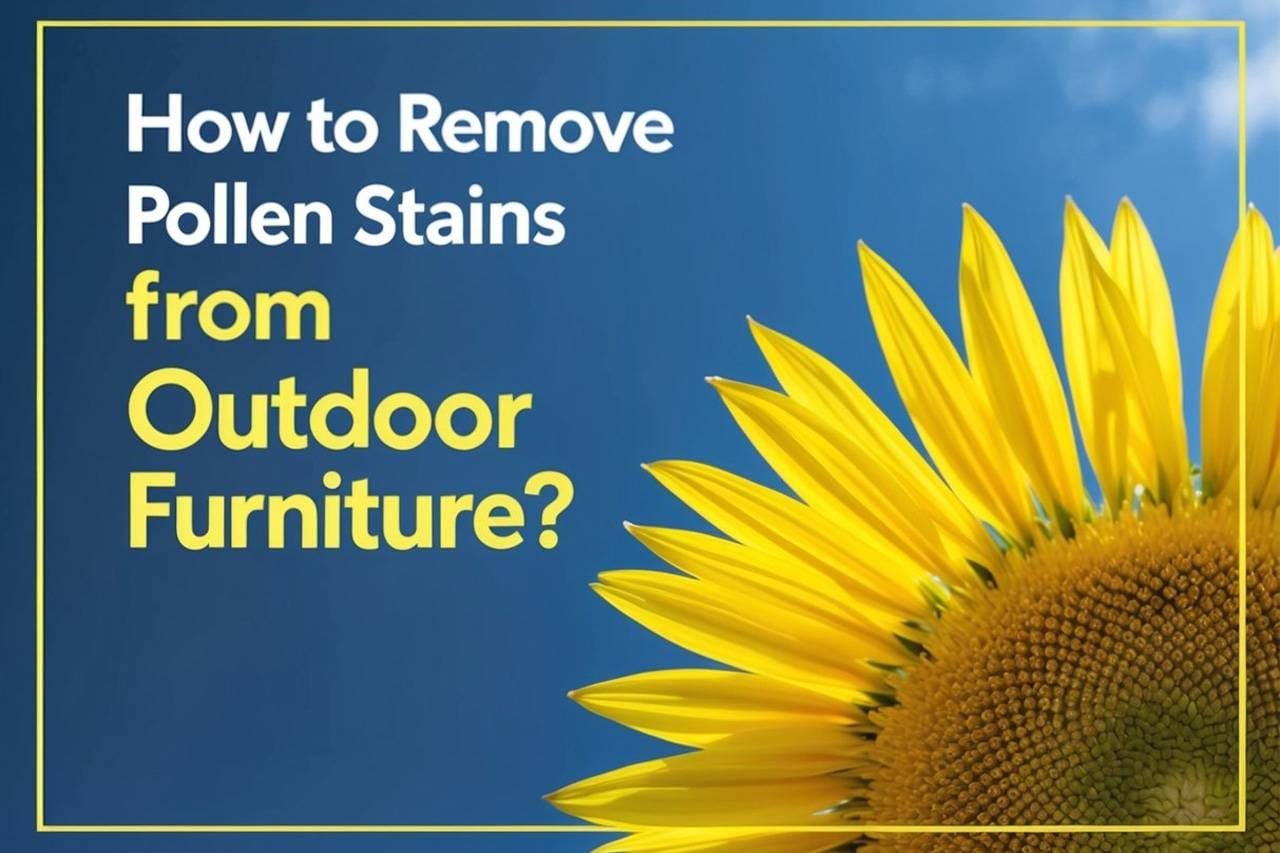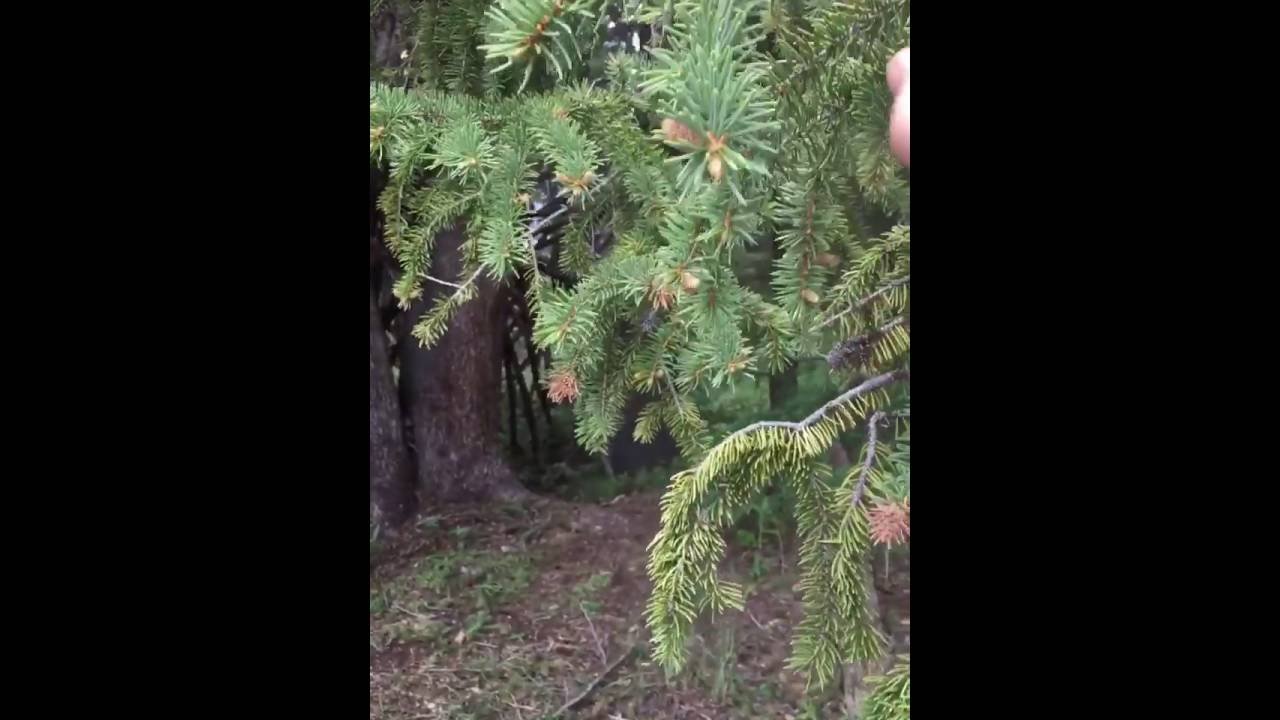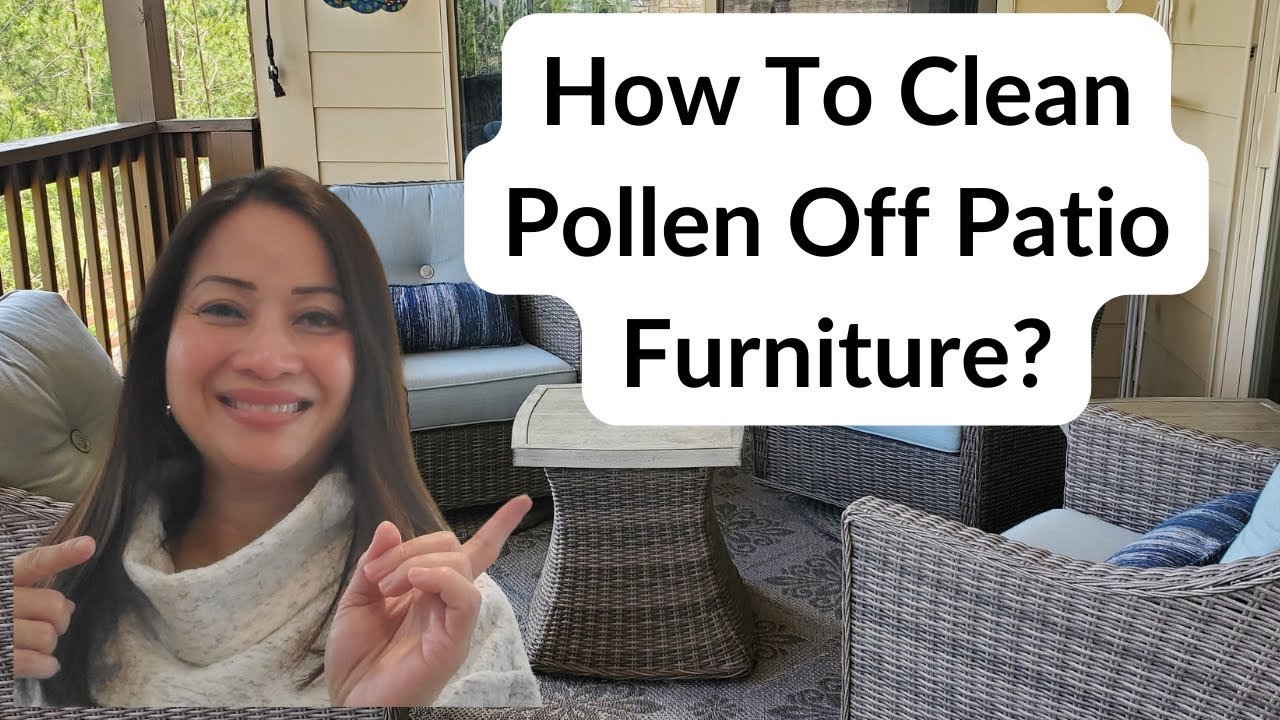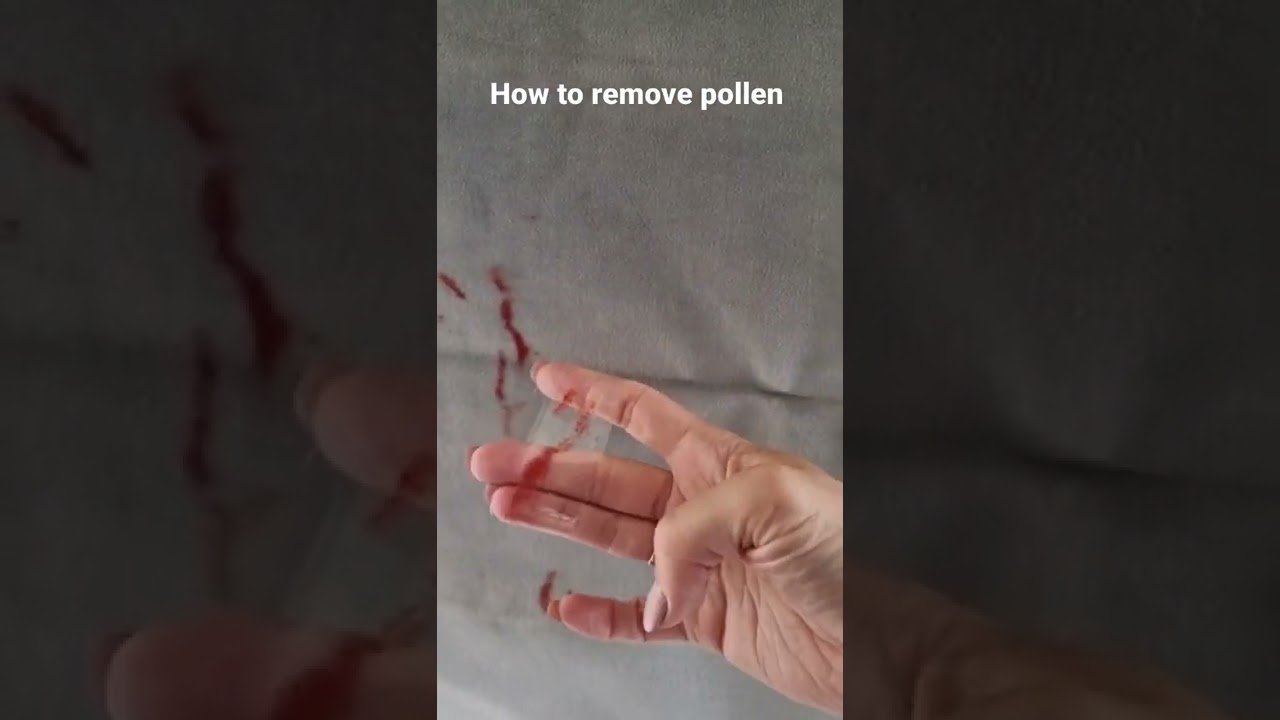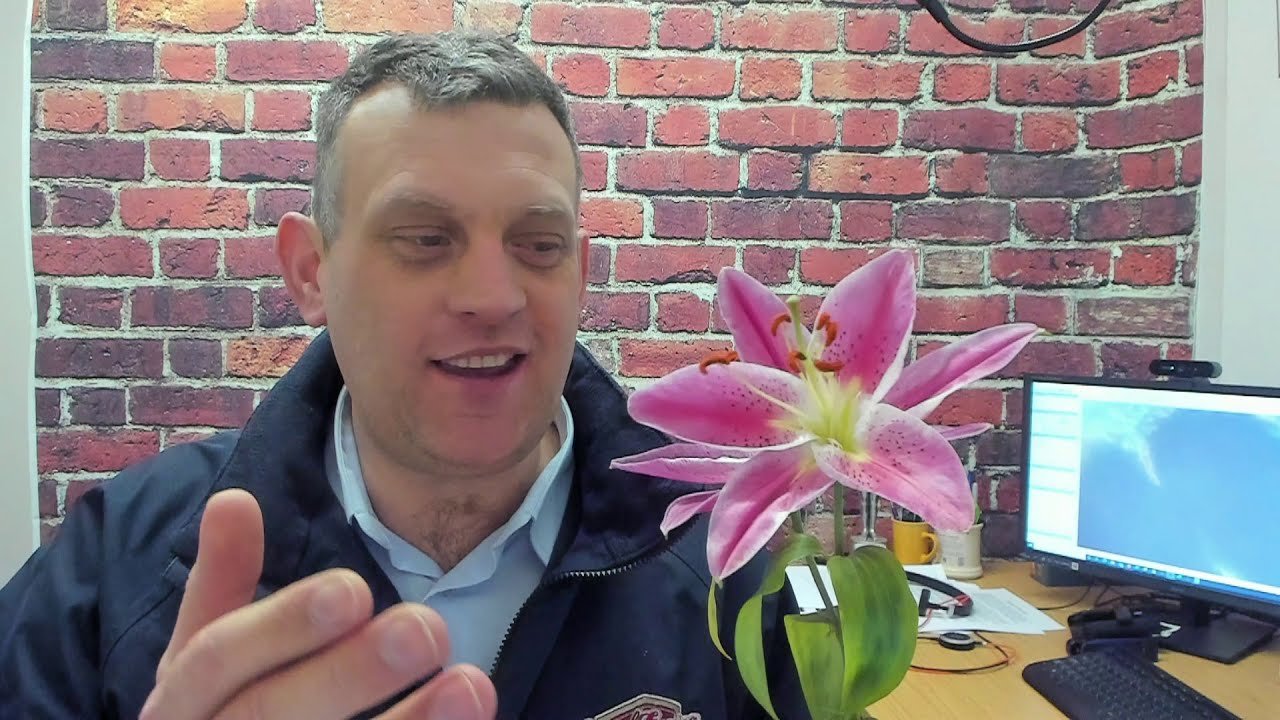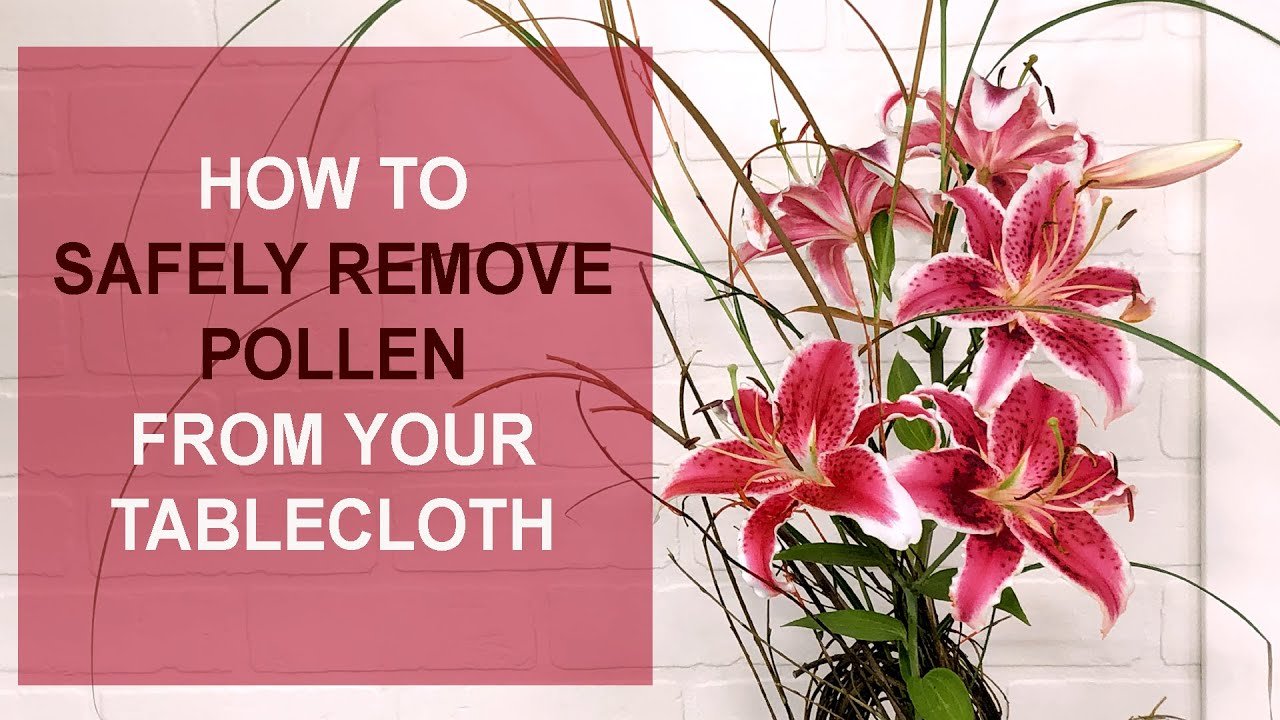Spring is here, and with it comes the beautiful blooms of flowers and trees. Unfortunately, those pretty blossoms also mean yellow pollen covering every surface of your outdoor space. When pollen lands on your patio furniture, it can leave stubborn stains that are frustrating to remove.
To remove pollen stains from outdoor furniture, mix dish soap with water in a spray bottle and gently wipe down surfaces with a soft cloth or sponge. For stubborn pollen, create a paste with baking soda and water, apply it to the stain, let it sit for 15-20 minutes, then rinse thoroughly. Different furniture materials may require specific cleaning approaches – wood, metal, and wicker each need slightly different treatment to avoid damage while effectively removing pollen stains.
In this article, we’ll walk through step-by-step methods for cleaning pollen from different types of outdoor furniture materials. We’ll also share preventative measures to reduce pollen buildup and protect your furniture during high allergy seasons. Whether you’re dealing with cushions covered in yellow dust or furniture frames stained by tree pollen, these tips will help you enjoy a clean, allergen-reduced outdoor living space all season long.
- Understanding Pollen and Its Mischievous Ways
- Pre-removal Pep Talk: Preparing Your Outdoor Palace
- Mission Removal: The Pollen Extermination Begins
- Spotless Spec Ops: Tackling Stubborn Pollen Stains
- The Great Outdoors Cleanup: Washing and Wiping Strategies
- Defensive Measures: Keeping Pollen at Bay
- Restoration and Recovery: Post-Pollen Pampering
- Wrap-up: The Sweet Smell of a Pollen-Free Paradise
- Frequently Asked Questions
Understanding Pollen and Its Mischievous Ways
Pollen might seem innocent, but it’s actually a sneaky invader that loves to make itself at home on your outdoor furniture. This fine powder has a knack for creating unsightly yellow stains that can turn your beautiful patio set into a mess during spring and summer months.
The Blooming Nuisance: What Is Pollen?
Pollen is a fine powdery substance produced by trees, flowers, grasses, and weeds as part of their reproductive process. It typically appears as a yellow dust that floats through the air and settles on surfaces.
This tiny troublemaker measures between 15-200 microns—smaller than a human hair! During pollen season, plants release billions of these microscopic particles into the air.
Pollen serves an important ecological purpose by helping plants reproduce, but it creates several problems for humans:
- Allergic reactions in many people
- Yellow staining on outdoor furniture and surfaces
- Respiratory issues for sensitive individuals
- Dirty appearance on patios and porches
Why Outdoor Furniture Attracts Pollen Like Bees to Honey
Your patio furniture becomes a magnet for pollen due to several factors. First, static electricity naturally builds up on furniture surfaces, especially plastics and metals, attracting airborne pollen particles.
Weather conditions play a major role too. Humid mornings create dew on furniture, which then catches and holds pollen. When the moisture evaporates, the pollen remains behind as those stubborn yellow stains.
The physical properties of your furniture also matter. Textured surfaces, fabric cushions, and porous materials provide perfect hiding spots for pollen to accumulate. Even a gentle breeze can deposit pollen onto your furniture from nearby trees and plants.
Pollen Hotspots on Outdoor Furniture:
- Cushion seams and fabric folds
- Table surface edges and corners
- Umbrella canopies
- Chair arms and backrests
Pre-removal Pep Talk: Preparing Your Outdoor Palace
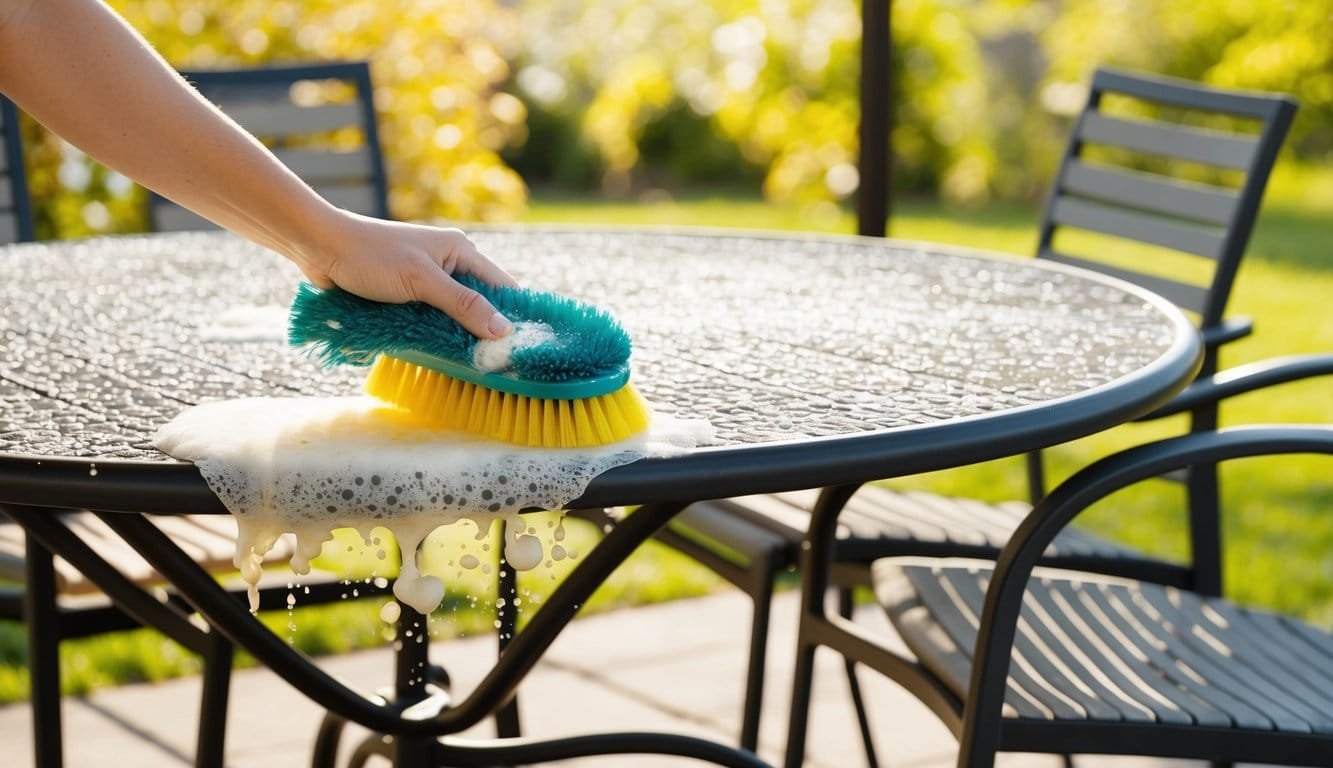
Before battling pollen stains, you’ll need to set up your workspace and gather supplies. The right preparation makes removing that stubborn yellow film much easier and protects your furniture from damage.
Safeguarding Against Pollen’s Fury
When pollen season hits, your beautiful outdoor furniture becomes covered in a thin yellow film that’s as stubborn as a toddler refusing bedtime. Prevention is your first line of defense!
Consider furniture covers when not in use – they’re like superhero capes for your chairs and tables. Remove covers by folding inward to trap pollen rather than spreading it everywhere.
If possible, move furniture to a covered patio or garage during peak pollen days. Weather apps now track pollen counts, so check before planning outdoor gatherings.
Quick Prevention Tips:
- Place furniture away from trees that produce heavy pollen
- Rinse furniture lightly each morning before pollen has time to set
- Apply furniture wax on applicable surfaces to create a protective barrier
Rounding Up the Troops: Tools and Materials
Every pollen battle requires the right equipment. Starting with a clean workspace makes the process much more effective and prevents you from just pushing yellow dust around.
Essential Pollen-Fighting Arsenal:
| Tool | Purpose |
|---|---|
| Garden hose with spray nozzle | Initial rinse to remove loose pollen |
| Vacuum with brush attachment | For fabric surfaces and cushions |
| Bucket of warm water | For mixing cleaning solutions |
| Soft cleaning cloths | For wiping without scratching surfaces |
| Soft bristle brush | For textured surfaces and stubborn spots |
For cleaning solutions, mild dish soap mixed with water works wonders. For wooden furniture, add a tablespoon of olive oil to your cleaning solution to moisturize while you clean.
Set up your cleaning station in a shaded area to prevent cleaning solutions from drying too quickly in direct sunlight.
Mission Removal: The Pollen Extermination Begins
Getting rid of pollen from outdoor furniture requires the right techniques and tools. With a few simple household items, you can wage war against those pesky yellow particles and restore your patio set to its former glory.
The Gentle Art of Vacuuming – Not Just for Indoors!
Vacuuming is your first line of defense against pollen invasion. Use a vacuum cleaner with a brush attachment to gently sweep away loose pollen without grinding it deeper into the furniture surfaces.
For wooden or metal furniture, a handheld vacuum works wonders. Make sure to use low suction settings to avoid damaging delicate surfaces. The crevice tool attachment is perfect for getting into those hard-to-reach corners where pollen loves to hide.
For fabric cushions, vacuuming is even more crucial. Start by removing loose pollen before applying any moisture, which could set the stain permanently. Some tips:
- Work in one direction rather than back and forth
- Use slow, deliberate passes to capture all particles
- Consider wearing a mask if you have allergies
- Vacuum outdoors if possible to prevent spreading pollen inside
Suds and Bubbles: Dish Soap to the Rescue
After vacuuming, dish soap becomes your secret weapon against stubborn pollen stains. Mix a few drops of mild dish soap with warm water in a spray bottle or bucket.
For hard surfaces like plastic, metal, or sealed wood, spray the solution directly onto the furniture and wipe with a soft cloth. The gentle detergents in dish soap break down pollen without damaging your furniture’s finish.
For cushions and fabrics, test the solution on an inconspicuous area first. Then apply with a soft cloth, gently dabbing rather than rubbing, which could push pollen deeper into fibers.
Rinse thoroughly with clean water to avoid soap residue, which can attract more dirt. For particularly tough stains, you might need to repeat the process or let the soap solution sit for 5-10 minutes before rinsing.
Spotless Spec Ops: Tackling Stubborn Pollen Stains
When pollen turns your beautiful patio furniture into a yellow battlefield, it’s time to bring in the special forces. Natural household items can be your best allies in this mission to restore your outdoor oasis.
The Secret Agents: Vinegar and Lemon Juice
Nature’s cleaning duo – vinegar and lemon juice – pack a powerful punch against stubborn pollen stains. These acidic heroes break down pollen particles without damaging your furniture surfaces.
Vinegar Solution:
- 1 part white vinegar
- 2 parts warm water
- 1 tablespoon mild dish soap
Mix these ingredients in a spray bottle and mist the affected areas. Let it sit for 5-10 minutes before wiping with a soft cloth. For wooden furniture, be sure to dry thoroughly to prevent warping.
Lemon juice works brilliantly for spot-cleaning those especially yellow patches. Simply squeeze fresh lemon juice onto the stain, let it sit for a few minutes, then wipe away. The citric acid dissolves the pollen while leaving a fresh scent behind.
For metal or plastic furniture, try this powerful combo: mix equal parts vinegar and lemon juice in a small bowl. Dip a soft cloth into the mixture and gently rub in circular motions. The pollen will lift away like magic!
Remember to test any solution on a small, inconspicuous area first. Some fabrics and materials might react differently to these natural remedies.
The Great Outdoors Cleanup: Washing and Wiping Strategies
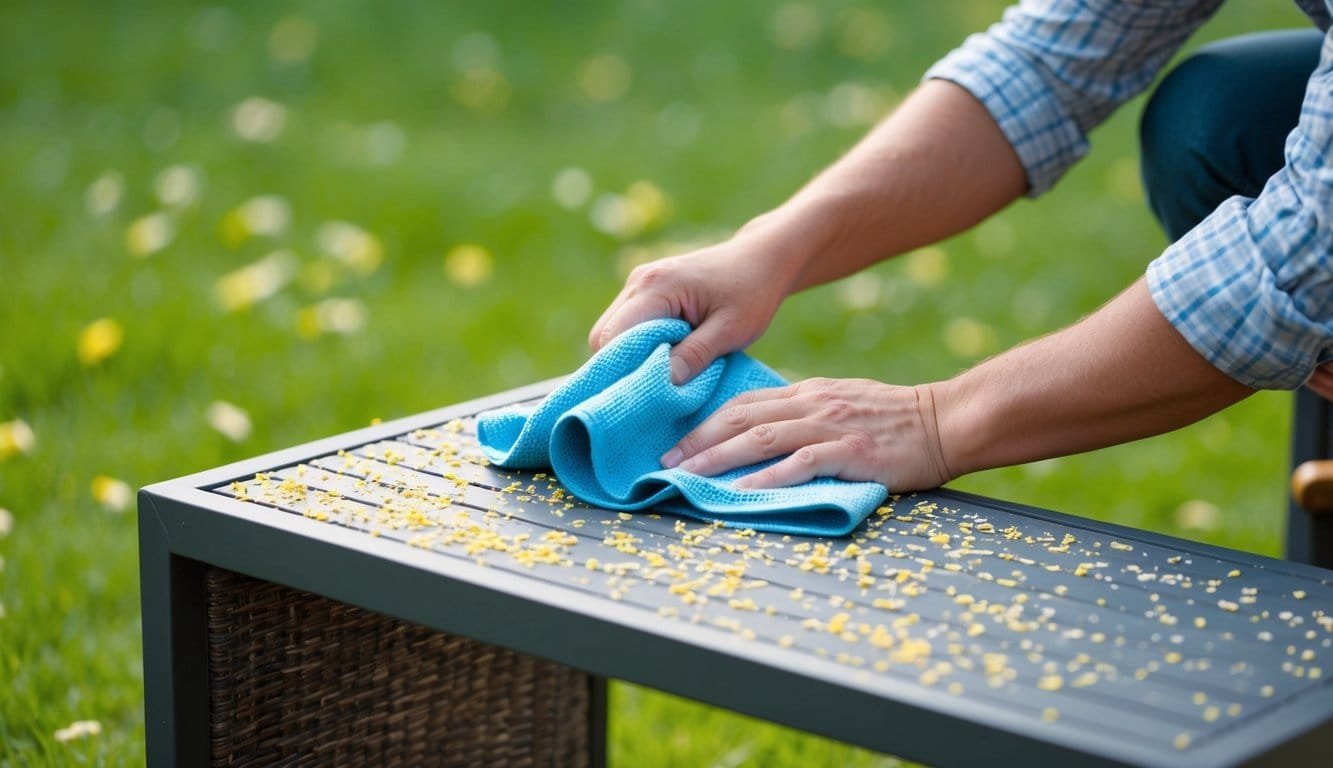
When pollen turns your beautiful patio furniture yellow, it’s time for action. The right cleaning approach makes all the difference between spotty results and furniture that looks fresh again.
Bucket List Success: Warm Water and Mild Detergent
The simplest solution often works best for cleaning pollen off your outdoor furniture. Grab a bucket, fill it with warm water, and add a squirt of mild dish soap. This gentle mixture breaks down pollen without damaging furniture finishes.
Dip a soft cloth into your soapy solution and wring it out. Wipe down each piece thoroughly, paying special attention to crevices where pollen likes to hide. For textured surfaces, a soft-bristled brush helps get into those tiny grooves.
Pro Tip: Work from top to bottom to avoid recontaminating cleaned areas.
After washing, rinse with clean water to remove soap residue. This prevents sticky surfaces that attract more pollen later. For best results, dry furniture completely with a clean towel to prevent water spots.
Pressure Tactics: Employing the Pressure Washer
For stubborn pollen buildup, a pressure washer can be your best friend. Before starting, remove cushions and fabric items that could be damaged by high-pressure water.
Important Safety Notes:
- Use the lowest effective pressure setting
- Keep the nozzle at least 12 inches from furniture surfaces
- Test on an inconspicuous area first
When pressure washing, move in smooth, consistent strokes across the furniture surface. This technique helps remove pollen from patio furniture without leaving streak marks or causing damage.
After pressure washing, allow furniture to air dry completely before replacing cushions. For metal furniture, consider applying a protective wax after cleaning to help repel future pollen deposits.
Defensive Measures: Keeping Pollen at Bay
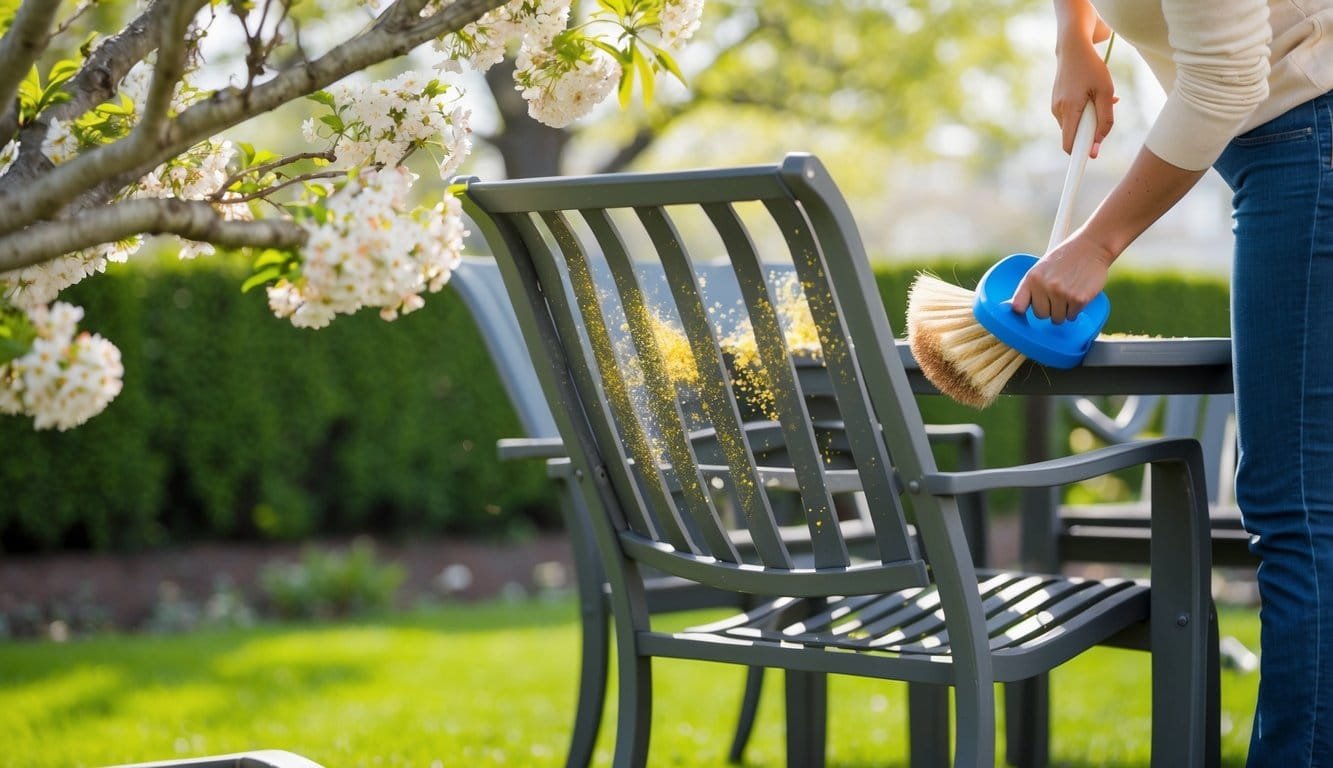
Taking preventative steps can dramatically reduce how often you’ll need to clean pollen from your outdoor furniture. The right protective gear and consistent maintenance make all the difference.
Suit Up, Furniture! The Armor of Covers
Protective covers are your first line of defense against pesky pollen. High-quality outdoor furniture covers act like shields, preventing pollen from settling directly onto your patio pieces.
Choose covers that:
- Are waterproof and UV-resistant
- Include secure fasteners to prevent wind removal
- Feature breathable material to prevent mold growth
Pro tip: Look for machine-washable covers when possible. This makes maintenance much simpler during high pollen seasons.
For cushions and fabric items, consider bringing them indoors when not in use. Even a garage or storage shed can make a huge difference in reducing pollen exposure.
Many covers now come in attractive designs that won’t make your patio look like a storage unit. The small investment pays off by extending furniture life and reducing cleaning time.
What’s the Schedule? Setting a Cleaning Routine
Consistency is key when battling pollen buildup. A regular cleaning schedule prevents pollen from becoming embedded in furniture surfaces.
Recommended cleaning frequency:
| Pollen Level | Cleaning Frequency |
|---|---|
| Low season | Every 1-2 weeks |
| Medium season | Weekly |
| High season | Every 2-3 days |
Morning cleaning works best since pollen counts are typically lower. A quick rinse with a garden hose might be all you need between deeper cleanings.
Set calendar reminders during peak pollen times. Just 5-10 minutes of maintenance can prevent hours of scrubbing later.
For extra protection, apply a protective sealant to wood furniture at the beginning of spring. This creates a barrier that makes pollen removal much easier.
Restoration and Recovery: Post-Pollen Pampering
After battling pollen, your outdoor furniture deserves some special attention to restore its beauty and extend its life. The right recovery techniques can make all the difference between furniture that looks tired and worn versus pieces that continue to shine season after season.
The Softer Side: TLC for Cushions and Soft Materials
Outdoor cushions often bear the brunt of pollen attacks and require gentle yet thorough cleaning. Start by removing any cushion covers that zip off and wash them according to their care labels. Most can handle a gentle cycle with mild detergent.
For non-removable covers, mix a solution of 1 tablespoon dish soap with 2 cups warm water. Gently scrub the fabric with a soft brush, paying special attention to seams where pollen likes to hide.
Quick Fabric Refresher Spray:
- 1 cup water
- ¼ cup white vinegar
- 5 drops essential oil (lemon works well)
- 1 tablespoon baking soda
For stubborn stains, try a paste of baking soda and water. Let it sit for 15-20 minutes before rinsing thoroughly. Always allow cushions to dry completely before replacing them to prevent mildew.
The Full Monty: Going for the Deep Clean
When pollen has thoroughly invaded your furniture, it’s time for a more comprehensive approach. For wooden furniture, use a mixture of mild soap and water, scrubbing with the grain to avoid damaging the surface.
Metal furniture responds well to a vinegar solution (1:3 ratio with water), which not only removes pollen but also helps prevent rust. For wicker furniture, use a vacuum with a brush attachment first to remove loose pollen from the crevices.
After cleaning, consider applying protective coatings:
- Wood: teak oil or furniture-specific sealant
- Metal: protective wax
- Wicker: clear polyurethane spray
For those with pollen allergies, wear a mask during deep cleaning sessions. It’s also wise to clean outdoor furniture regularly during high pollen seasons rather than waiting for a major buildup.
Wrap-up: The Sweet Smell of a Pollen-Free Paradise

Keeping outdoor furniture free from pollen doesn’t have to be a constant battle! With regular cleaning and some preventative steps, anyone can enjoy their outdoor living space without the yellow dust taking over.
Remember to act quickly when pollen lands on furniture. The faster someone addresses it, the less likely it will become a stubborn stain requiring extra effort to remove.
For those who love flowers but hate the mess, consider these quick tips for maintaining a pollen-free paradise:
- Store cushions indoors during high pollen seasons
- Use furniture covers when not in use
- Keep smaller furniture pieces in a garage when pollen counts are high
- Create a cleaning schedule during spring months
- Choose low-pollen plants for garden areas near seating
The outdoor environment will always have some pollen, but regular maintenance makes a huge difference. A quick wipe-down with appropriate cleaners every few days can prevent buildup that becomes harder to remove later.
For those stubborn yellow spots that do appear, don’t panic! The foolproof tricks mentioned earlier will have that furniture looking fresh again in no time.
With these simple strategies, anyone can enjoy their outdoor furniture without constantly battling the yellow dust. Here’s to breathing easy and enjoying outdoor spaces—minus the pollen problems!
Frequently Asked Questions
Pollen stains on outdoor furniture can be stubborn, but with the right cleaning methods, you can quickly restore your patio pieces to their former glory. Here are answers to common questions about tackling those pesky yellow pollen marks.
What’s the secret to banishing pollen stains from your cozy outdoor lounge chairs?
The secret to removing pollen from lounge chairs is to avoid brushing or wiping it dry. This only pushes pollen deeper into the fabric or spreads it around.
Instead, use a garden hose to spray off loose pollen first. For stubborn stains, mix mild dish soap with warm water and gently scrub with a soft brush.
Let the solution sit for 5-10 minutes before rinsing thoroughly with clean water. This method works great for most outdoor furniture materials!
Is there a magic potion to scrub away those pesky yellow marks off our beloved patio sets?
While no magical potion exists, a simple mixture of water and white vinegar (equal parts) works wonders on pollen stains.
Spray this solution directly on affected areas and let it sit for about 15 minutes. The acidity in vinegar breaks down pollen particles effectively.
For tougher stains, try making a paste with baking soda and water. Apply it to the stained area, let it dry, and then rinse off. This natural cleaner is gentle yet powerful against yellow pollen marks.
Can we tackle pollen stains on our decks without turning it into a science fair project?
Absolutely! Cleaning pollen from decks can be surprisingly simple. Start by investing in a waterproof cover to prevent pollen buildup in the first place.
When it’s cleanup time, a pressure washer on low setting works wonders. If you don’t have one, a stiff broom followed by a good hosing down will do the trick.
For wood decks, mix oxygen bleach with warm water and scrub gently with a deck brush. This removes pollen without damaging the wood’s finish or color.
Hey, got any tricks up your sleeve for wiping away that stubborn pollen on wood surfaces without a hitch?
For wooden furniture, avoid using excessive water which can damage the finish. Instead, use a slightly damp microfiber cloth to gently lift pollen away.
A mixture of 1 tablespoon olive oil with 1 tablespoon white vinegar creates a perfect wood-friendly cleaning solution. Apply with a soft cloth, moving in the direction of the wood grain.
For sealed wood, Murphy’s Oil Soap diluted with water works great to remove pollen while conditioning the wood. Remember to dry wooden furniture thoroughly after cleaning to prevent warping.
Is there a hero cleaner out there ready to rescue my outdoor cushions from the grip of pollen stains?
Outdoor cushions can be saved with a mixture of 1 teaspoon dish soap, 1 tablespoon Borax, and 1 quart warm water. This hero solution breaks down pollen without fading fabrics.
For removable cushion covers, check care labels first. Many can be machine washed on a gentle cycle with mild detergent, which effectively eliminates pollen.
Non-removable cushions can be treated with fabric-safe enzyme cleaners designed for outdoor use. These specialized cleaners break down pollen particles without damaging the cushion material.
Are those springtime pollen splatters a match for a good ol’ fashioned home cleanup?
Those yellow pollen splatters don’t stand a chance against good old-fashioned cleaning methods! Simple household items often work better than expensive cleaners.
A mixture of warm water and lemon juice creates an acidic solution that dissolves pollen effectively. The citrus also leaves a fresh scent behind.
Regular maintenance is key – a quick rinse with a hose every few days during heavy pollen season prevents buildup. Five minutes of prevention saves hours of deep cleaning later!

